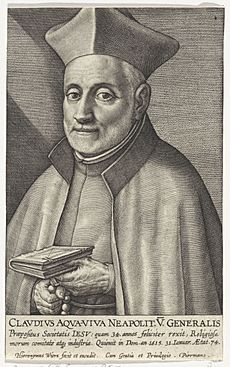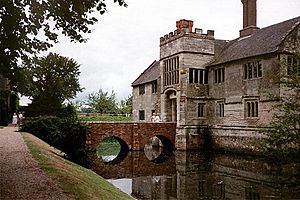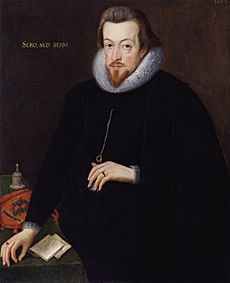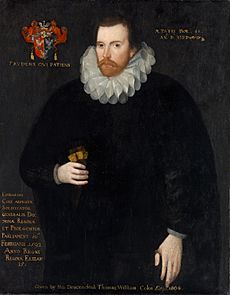Henry Garnet facts for kids
Quick facts for kids
The Rev.
Henry Garnet
|
|
|---|---|

A portrait of Garnet pointing to the bloodstained straw husk saved from the scene of his execution and said to bear his image
|
|
| Born | July 1555 Heanor, Derbyshire, England
|
| Died | 3 May 1606 (aged 50) St Paul's, London
|
| Cause of death | Execution |
| Occupation | Jesuit superior in England |
| Parent(s) | Brian Garnett, Alice Jay |
| Conviction(s) | Treason |
| Criminal penalty | Hanged, drawn and quartered |
|
Date apprehended
|
27 January 1606 |
Henry Garnet SJ (born July 1555 – died 3 May 1606) was an English Jesuit priest. He was executed for a serious crime against the king, called high treason. This happened because he knew about the 1605 Gunpowder Plot but did not tell the authorities. He felt he could not tell because the information was shared with him during a religious confession.
Henry Garnet was born in Heanor, England. He studied in Nottingham and at Winchester College. In 1571, he moved to London to work for a publisher. He became interested in law. In 1575, he traveled to Europe and joined the Society of Jesus, a Catholic religious order. He became a priest in Rome around 1582.
Contents
Henry Garnet: A Life of Faith and Secrets
Early Life and Education
Henry Garnet was born in July 1555 in Heanor, Derbyshire. His father, Brian Garnet, was a school master in Nottingham. Henry had five siblings. His three sisters later became nuns.
Henry went to grammar school in Nottingham. In 1568, he started at Winchester College. He was a very good student. He loved music and could sing beautifully. He also played the lute. People at his school thought he was very talented.
Life in Rome
Instead of going to Oxford University, Henry Garnet moved to London in 1571. He worked for a company that published legal books. He often ate with Sir John Popham, who later became a very important judge.
In 1575, Garnet sailed to Portugal and then to Rome. On September 11, 1575, he joined the Society of Jesus. He studied with famous teachers like Father Robert Bellarmine. His teachers praised his skills. Around 1582, he became a priest. He taught Hebrew, mathematics, and philosophy in Rome.
In 1584, Father Robert Persons asked for Garnet to be sent to England. The leader of the Jesuits, Claudio Acquaviva, first said no. He thought Garnet was better suited for a quiet life. But on May 2, 1586, he allowed Garnet to go. Garnet traveled with Robert Southwell and arrived in England in July 1586.

Returning to England
When Garnet arrived in England, he met William Weston, who was the Jesuit leader there. They met at an inn in London. They planned to meet twice a year to discuss their work. Weston also told them about Catholic homes where they could stay safely.
Soon after, Weston was captured by English authorities. So, Henry Garnet became the new Jesuit leader in England. He was allowed to print Catholic books secretly. He set up a secret printing press in London. It operated until late 1588.
In November 1588, Garnet saw a parade celebrating England's victory over the Spanish Armada. Spain's attempt to invade England had failed. This made things harder for Catholics in England. Garnet wrote to his leader, saying that many people thought he cared more about the Queen than her Protestant ministers.

Being a Jesuit in England was dangerous. Jesuits had been banned since 1585. If caught, they could be charged with treason. Garnet had to avoid being captured many times. In 1591, he was almost caught at Baddesley Clinton. After this, he divided the Jesuit mission into smaller groups.
Garnet believed it was his duty to secretly attend the executions of other priests. He would disguise himself to give them their last blessings. He may have been at the execution of Robert Southwell in 1595. Southwell's death was very sad for Garnet.
In 1593, Garnet visited Wisbech Castle. This castle was used to hold Catholic priests. He helped settle a disagreement between different groups of Catholic priests there. This argument was called the Wisbech Stirs.
The Gunpowder Plot Connection
In 1605, Henry Garnet met Robert Catesby. Catesby was a nobleman who secretly planned to kill the Protestant King James I. Catesby asked Garnet about the rightness of "killing innocent people." Garnet explained that in war, innocent people sometimes die. Garnet thought Catesby might be planning to raise an army in another country.
Garnet was very different from Catesby. Catesby was ready to use violence for his beliefs. Garnet believed in peaceful solutions. He was happy when King James became king. He hoped there would be no more violence. He had even approved of Catholic priests telling the authorities about an earlier plot in 1603. He always told English Catholics not to use violence.
In July 1605, another priest, Father Oswald Tesimond, told Garnet about Catesby's plan. This information was given to Tesimond in a religious confession. Because of this, Garnet felt he could not tell the authorities. Catholic law prevented him from doing so. Instead, Garnet strongly urged Catesby to stop his plot. Garnet also wrote to his leaders in Rome. He asked them to tell English Catholics not to use violence.
When Parliament was postponed in July, Garnet thought the danger had passed. He believed his warnings had worked.
Arrest and Questioning

On November 6, 1605, the Gunpowder Plot failed. Garnet was at Coughton Court when he heard the news. Catesby wanted him to help gather support in Wales. But Garnet was shocked. He wrote to Catesby, telling him to stop his "wicked actions."
Garnet went into hiding for several weeks. But on January 27, 1606, he was arrested at Hindlip Hall. He and another priest, Edward Oldcorne, had been hiding in a tiny, cramped space for eight days. They were very weak when they were found.
They were taken to London. Garnet was questioned by important government officials, including Salisbury. They treated him with respect but tried to trick him. Garnet admitted some of his movements. He said he received Catesby's letter after the plot failed. But he denied being involved in the plot itself.
Garnet was moved to the Tower of London. He was put in a "very fine chamber." His conversations with Oldcorne, who was in a nearby cell, were secretly listened to by government spies. His letters to friends were also read by the authorities.
Garnet's answers were always very careful. He knew that he might be tortured. But he remained strong. He believed that the government did not have enough proof against him. However, in early March, he confessed that he had known about the plot beforehand. This confession gave the government proof that he had prior knowledge. They believed this made him guilty of treason.
The Trial and His Fate

Garnet's trial took place on Friday, March 28, 1606, at the Guildhall. He was brought in a closed carriage, which was unusual. The trial lasted all day. King James himself was there, hidden from public view.
Garnet was accused of planning with Catesby to kill the king and his son. He was also accused of trying to change the government and religion in England. He said he was "not guilty."
The government's lawyer, Edward Coke, said Garnet was involved in every plot since 1586. Coke called Garnet a "doctor of five Ds," meaning he was good at hiding the truth and causing trouble.
Garnet defended his use of "equivocation." This was a way of speaking that allowed a person to hide the full truth without directly lying. He said it was only for certain situations. But the court saw it as simple lying.
Garnet said he had told Catesby not to go ahead with the plot. But the jury decided he was guilty of treason in just fifteen minutes. He was sentenced to be executed.
On May 3, 1606, Henry Garnet was taken to St Paul's churchyard for his execution. He wore a black cloak. He prayed and said he had not done anything wrong against the king. He said he was only following the rules of confession. If that offended the king, he asked for forgiveness.
He was thrown off the ladder. Many people in the crowd pulled on his legs. This meant he died quickly and did not suffer the full, harsh punishment. His head was placed on a pole on London Bridge. People were so curious about it that the government had to turn it so the face could not be seen.
A straw husk with Garnet's blood on it was saved from the execution site. People said it showed his image. This became a famous object.
His Writings
Henry Garnet wrote several books. One was An Apology Against the Defence of Schisme (1593). In this book, he criticized Catholics who sometimes attended the Church of England.
He also wrote A Treatise of Christian Renunciation (1593). This book had quotes about what Catholics should be willing to give up for their faith.
His most famous writing was A Treatise against lying and fraudulent dissimulation (around 1598). This book explained his ideas about "equivocation." Most Protestants thought this was just lying. Even William Shakespeare might have mentioned Garnet in his play Macbeth. A line in the play talks about someone who "could not equivocate to heaven."
Images for kids


